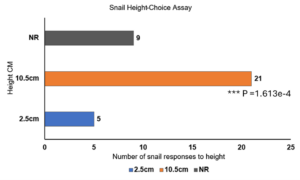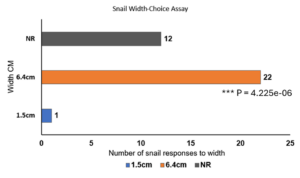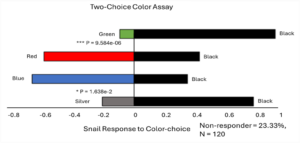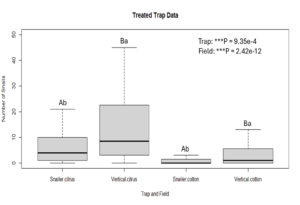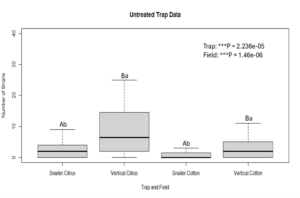Progress report for GS24-300
Project Information
Bulimulus bonariensis is an invasive species of snail native to southeastern South America. It was first reported in Florida in 2009 but did not become an issue until 2015. This snail poses a significant threat to crops such as cotton, blueberry, and squash, adversely impacting harvest quality and disrupting crop health. In peanuts and blueberries, growers face the challenge of snails contaminating harvest, lowering quality, and increasing costs through sorting. In citrus, snails clog irrigation components and frost protective lines due to heavy aggregation near moisture. Other crops such as soybeans, snap peas, and cotton are exposed to the most harm in the earliest stages of growth causing lodging. Climbing is a notable behavior for B. bonariensis linked to estivation, a diapause-like state triggered by a change in moisture levels throughout the year. To develop a sustainable management strategy, we aim to design a new trap that captures the behavior of estivation. The trap was designed based on lab evaluations that found snails are attracted to dark colors and tall structures. Additionally, previous studies have shown fermented bread dough to be an effective and inexpensive attractant, while caffeine was found to be an effective toxicant and repellent that deters snails. This study plans to utilize new traps, bread dough, and caffeine extract to develop a more sustainable approach to snail management. The predatory efficiency of native biological control agents such as the predatory snail Euglandina Rosea (Rosy Wolf Snail), carabid beetles, and the two-spotted earwig will be investigated.
- Evaluation of a new trapping system, an attractive bait, and a repellent for the management of B. bonariensis
- Utilizing laboratory preliminary data from color-choice assays and material parameters, we will compare a homemade trapping system to a commercial trap.
- Test the use of bread dough as a snail attractant and caffeine as a snail repellent in conjunction with trap types in field settings.
- Identify natural enemies of B. bonariensis and their efficacy.
- Survey of potential natural enemies of B. bonariensis in a peanut and cotton system.
- Determine the success of natural enemies of B. bonariensis through lab bioassays and predator exclusion cages in field settings.
Research
Objective 1. Evaluation of a new trapping system, an attractive bait, and a repellent for the management of B. bonariensis
Prior to designing field traps, an investigation of snail visual cues determined B. bonariensis is visually attracted to dark colors and wide vs. narrow material to crawl upwards. Many species of terrestrial snails, including B. bonariensis, are commonly observed climbing/aggregating up structures or plants due to a behavior called estivation. The development of vertical traps is designed to capture this behavior and attract snails into a single location, allowing them to be dispatched quickly and harmlessly away from the crop. Further, building on prior research done with terrestrial snails and slugs, bread dough has shown to be a very inexpensive and readily available lure for snails. The dough (made with yeast, water, and flour) was found to be attractive to snails for up to 8 days, more effective than commercially available metaldehyde-based snail lures, and successfully lured 6 different invasive snail species (Veasey et al. 2021). Caffeine has been shown to be a highly effective repellent and toxicant with a 1% drench solution applied to the soil, causing 100% of snails to vacate, and was more effective than commercially available liquid metaldehyde (Hollingsworth et al. 2003).
Trap Design:
Our vertically designed traps will be made of 4” x 36” PVC tubes mounted to 48” t-posts. The stakes and PVC pipes will be painted black to increase snail attraction.
Experimental Design:
|
Treatments |
Trap Type |
Bread Dough |
Caffeine |
|
1 |
Vertical |
X |
- |
|
2 |
Snailer |
X |
- |
|
3 |
Vertical |
X |
X |
|
4 |
Snailer |
X |
X |
|
5 |
Vertical |
- |
- |
|
6 |
Snailer |
- |
- |
Field traps will be deployed at two field sites, one citrus and one peanut field, where active populations of this snail have been established for several years.
24 traps, 12 lab-designed vertical traps, and 12 commercially available snail traps will be deployed at each field site.
The design consists of six treatments: two trap types, baited with bread dough, baited with bread dough and the base drenched with caffeine as a deterrent, and unbaited controls. All treatments will be randomly placed in six blocks on each side of a cotton field for four replications. In citrus all 6 treatment blocks will be randomized and placed within the grove for four replications. Individual traps will be placed 5m apart. Traps will be baited and sampled bi-weekly for a period of 7 days over the growing season until harvest for two years. The total number of snails will be counted and then dispatched at the time of collection.
Objective 2. Identification of natural enemies of B. bonariensis and their potential impact on snail populations.
The goal of this study is to measure the predation of B. bonariensis by natural enemies present in peanut and cotton field. In order to evaluate the contribution of the different groups insects that may actively be predators of the snail's different predator exclusion treatments will be established.
Experimental Design:
A 5x4 RCB will be conducted in a peanut field planted at the NFREC in Quincy, FL. Peanut plots will be 4-row plots 10ft x 25 ft (WxL).
Treatments:
- Control: no cage
- All predator exclusion: caged peanut plants with mesh buried into the ground.
- Flying predator exclusion: cage with a 2’’ opening at the bottom to allow ground predators
- Cage fixed to ground but open roof to prevent walking predators but allow for flying predators
Cages (1m x 1m) will be placed over the middle two rows of the four row plots. A clutch of 10 B. bonariensis eggs will be placed in the middle of the 1 x 1 cage for a 1-week period. After one weeks, the eggs will be counted, and any remaining will be brought back to the lab for observation of any potential consumption.
Survey of Natural Enemies
A series of pitfall traps baited with 10 deceased B. bonariensis snails (without preservatives) will be placed in the peanut and cotton plots to capture potential predators alive. The pitfall traps will be checked after one week in the field, and live specimens will be taken into the lab for a feeding assay. Predatory insects will be starved for 24 hours, then isolated with 10 B. bonariensis eggs in an arena. These predators will be monitored every 4, 8, 12, and 24 hours for the number and rate of egg consumption. This will be replicated 20 times per species found. After assays, specimens will be identified to family or furthest taxon possible in the lab and voucher specimens will be sent to FDACs for identification confirmation.
Efficacy of Rosy Wolf Snail on B. bonariensis
We currently have a colony of rosy wolf snails in our laboratory. Rosy wolf snails of different sizes will be put in containers with 10 B. bonariensis snails and monitored over a 2 year period. The empty shells of consumed B. bonariensis snails will be counted each day to determine average daily consumption. Additionally, hatchlings of rosy wolf snails will also be provided with 10 young B. bonariensis snails to determine the size of prey they require, survival rate, clutch size, and growth to maternity. With this data, the functional response of rosy wolf snails in relation of their size will be determined.
Educational & Outreach Activities
Participation Summary:
ESA, November 2024: 10 minute oral presentation of snail objectives related to trap and treatment outcomes and data
ESA Southeastern branch meeting, March 2025: 10 minute oral presentation of snail objectives related to trap and treatment outcomes and data
Workshop on Management of Terrestrial Gastropods, March 2025: 10-minute oral presentation of snail objectives related to trap and treatment outcomes and data, additionally Dr. Esquivel presented a 10-minute talk on our findings of E. rosea and natural enemies in peanut and cotton crops.
Project Outcomes
Snail Trap
Through preliminary research we determined that Bulimulus bonariensis is visually attracted to darker colors, plus wide and tall trap supports. Visual perception of this snail species likely senses light and shadow in the field setting to allow them to climb various objects or plants, thus lighter colors significantly repelled the snails, while darker colors were not significantly chosen over black. This data was determined through laboratory assays using a two-choice arena test and chi-square statistical analysis. This data was then used to develop a new vertical trap which we tested against the commercially available Snailer trap in both a citrus grove and cotton field. Using a 3-way ANOVA, we found that the newly designed vertical trap had a much stronger response and capture rate of B. bonariensis than the commercial trap.
We also tested a potential snail attractant (bread dough) and snail repellent (caffeine) in each trap, however, we found that neither the attractant nor repellent significantly affected snail behavior or capture rate. Snail were also collected in the traps with no attractant or repellents present which we statistically analyzed using a 2-way ANOVA (untreated data). We have decided to continue researching new potential attractants and repellents in the lab setting before retesting them in the field, thus, this data is still on-going.
After sharing the results of our new snail trapping design, other UF IFAS research stations combating snail pest issues have considered testing it in their groves and crops in south Florida, thus, more data will be collected.
Natural Enemies
The Florida native predatory snail Euglandina Rosea was collected and reared in a laboratory colony and assessed daily for consumption of B. bonariensis snails over a year and half period. This data determined that E. rosea is not likely a good option for natural enemy control due to difficulty rearing hatchlings and a low predation rate. As many as 200 E. rosea eggs were laid in 3 months but only two of those hatchlings survived beyond two months of age. Additionally, E. rosea only consumed an average of one B. bonariensis snail per day, thus, predation is likely too low for adequate control in field settings.
Natural predators were also collected in peanut and cotton crops using pitfall traps. These predators were kept alive and assessed for consumption of B. bonariensis eggs in a lab setting. We primarily captured earwigs, carabids, and tiger beetles which were monitored for consumption of the snail eggs over a 24 hour period. The results of this data is on-going as we intend to change the protocol of this data to extend the time the predators have with B. bonariensis eggs and change the predation assessment containers to be less stressful for predators.
Predatory exclusion cages were also deployed in a peanut field to assess consumption rate of B. bonariensis eggs. Each cage allowed for different types of predators to reach the eggs, thus, different consumption rates of the eggs will help to determine the primary sources of predation. Due to heavy rain in fall of 2024, this data is this on-going and will conclude in fall of 2025.
DATA Results:
Height
Chi-square
Height: X-squared = 14.235, df = 1; P value = 1.613e-4
Width
Chi-square
Width: X-squared = 21.16, df = 1; P value = 4.225e-06
Color
Chi-square:
Green: P value = 9.584e-06
Silver: P value = 1.638e-2
Treated Trap Data
Three-way ANOVA (treatment x trap x field):
- Significant trap effect
Df = 1, 303; P = 9.35e-4
- Significant field effect
Df = 1, 250; P = 2.42e-12
- No effect of caffeine and dough
Df = 4, 283; P = 0.6
Untreated Trap Data
Two-way ANOVA:
- Significant trap effect
Df = 1, 163; P = 2.236e-05
- Significant field effect
Df = 1, 189; P = 1.46e-06
Throughout the course of this research we determined that our research objectives are widely applicable to other snail pest issues occurring through out the southeastern US. This increases the potential impact and sustainability of research outcomes.
